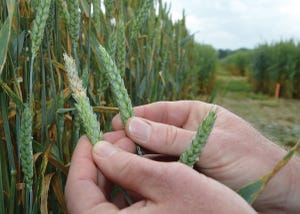April 26, 2016

Wheat acreage in Louisiana is at an all-time low of 58,000 to 60,000 acres, LSU AgCenter experts said at a wheat and oat field day at the April 20 AgCenter Macon Ridge Research Station.
Low prices, scab disease in 2015 and wet weather at planting are the reasons, said Boyd Padgett, AgCenter wheat specialist. In particular, scab disease “left a bad taste in growers’ mouths.”
Fusarium head blight – known as scab – caused about a yield loss of about 25 percent last year, said Trey Price, AgCenter plant pathologist. “It’s been a tough year for wheat.
“We are screening varieties for scab resistance adapted to the Gulf South.”
The research at the station is important, he said, because “we’re going to need this information wheat comes back in Louisiana.”
Wet weather in fall affected farmers’ decisions about planting.
The planting window for wheat in Louisiana is mid-October to mid-November, said Steve Harrison, AgCenter small grains breeder.

A head of wheat infested with scab disease on left is compared with a wheat head that’s disease-free. Photo by Tammi Arender, LSU AgCenter (Click to enlarge)
A head of wheat infested with scab disease on left is compared with a wheat head that’s disease-free. Photo by Tammi Arender, LSU AgCenter (Click to enlarge)Harrison walked through the plots and commented on each variety. Representatives from commercial seed companies that have varieties in the plots were given the opportunity to comment on their companies’ varieties.
“It’s important to think about planting date and heading date,” Harrison said. For wheat plants to make seed requires vernalization, which is a period of about six weeks of 40-degree weather in Louisiana.
Harrison pointed out how vernalization was affected by a warmer-than-normal winter as he reviewed dozens of variety trials during the field day.
“Vernalization is important based on location. There are about 20 varieties planted here at Macon Ridge that I can’t plant in my plots in Baton Rouge because it’s much warmer there.”
Planting date was also the topic for agronomist Rick Mascagni, who introduced a new research program looking at wheat production and later planting dates.
Mascagni’s trial was started in fall 2015 using three wheat varieties of different maturities planted on three dates past the optimal planting time frame.
Although the results won’t be available until after harvest in the spring, Mascagni said initial indications are that as planting was delayed, the differences in maturity narrowed.
Weed control and wheat yield can be optimized with fall herbicide applications, said Josh Copes, AgCenter research associate. Start with clean fields, using either paraquat or glyphosate at planting to control breakthrough weeds.

LSU AgCenter small grains breeder Steve Harrison with back to camera reviews the results of individual wheat trials during the annual wheat and oat field day at the Macon Ridge Research Station on April 20. Photo by Tammi Arender, LSU AgCenter (click to enlarge)
LSU AgCenter small grains breeder Steve Harrison with back to camera reviews the results of individual wheat trials during the annual wheat and oat field day at the Macon Ridge Research Station on April 20. Photo by Tammi Arender, LSU AgCenter (click to enlarge)Soil acidity, or pH, is the top priority for wheat fertility programs, said Brenda Tubana, AgCenter soil scientist. “Fertilizer is 30 to 33 percent of the production costs for wheat. Use soil tests and timely applications.”
Aphids are a problem in wheat early when weather is warmer, said Sebe Brown, AgCenter entomologist. They are a vector for barley yellow dwarf virus, which can be controlled by seed treatment.
“It takes a lot of aphids to require insecticide applications,” Brown said.
Louisiana has no fly-free date for Hessian fly, and they produce four to six generations in a year.
“Resistance has given us a really good tool,” Brown said. But use seed treatment if not using a resistant variety.
Because stink bugs migrate into wheat fields from other grasses, controlling grass weeds helps control stink bugs.
Armyworms also can infest wheat fields, Brown said. Growers need to scout early in the morning when the worms are active.
Pyrethroid insecticides are effective on stink bugs and armyworms, he said. The threshold for army worms is five worms per square foot.
Scott Stewart, professor, UT Department of Entomology and Plant Pathology, 731-425-4709, [email protected].
Ginger Rowsey, UTIA Marketing and Communications, 731-425-4768, [email protected].
You May Also Like




